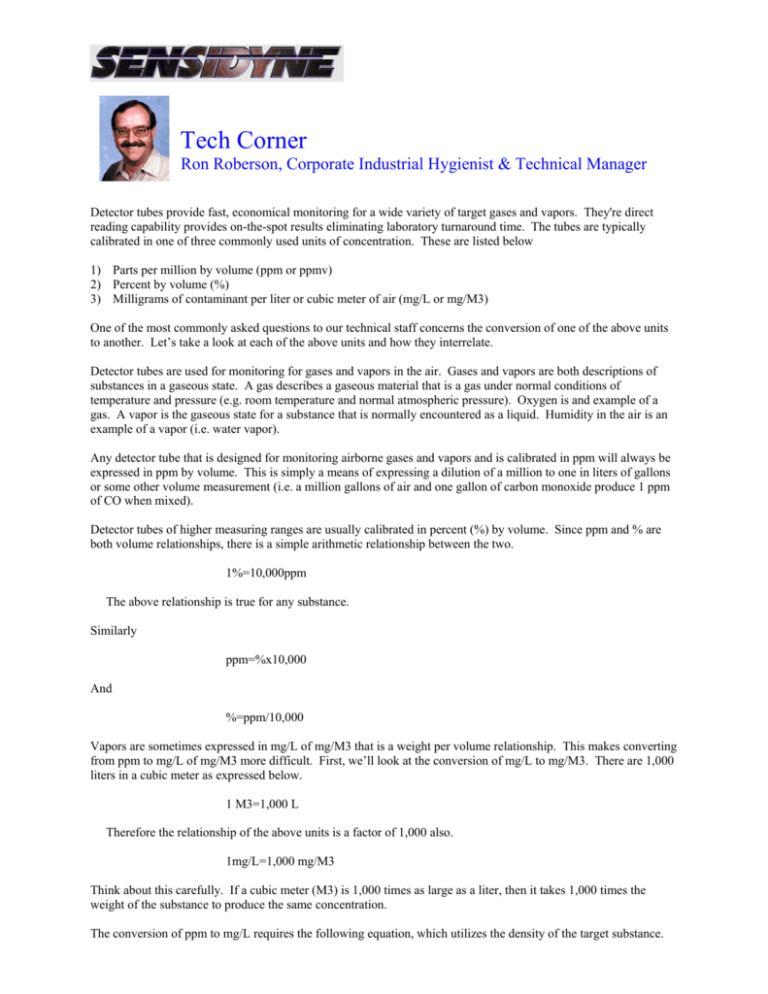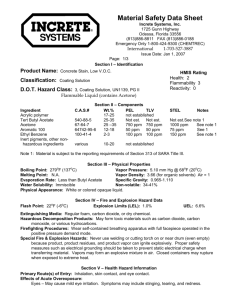Tech Corner
advertisement

Tech Corner Ron Roberson, Corporate Industrial Hygienist & Technical Manager Detector tubes provide fast, economical monitoring for a wide variety of target gases and vapors. They're direct reading capability provides on-the-spot results eliminating laboratory turnaround time. The tubes are typically calibrated in one of three commonly used units of concentration. These are listed below 1) Parts per million by volume (ppm or ppmv) 2) Percent by volume (%) 3) Milligrams of contaminant per liter or cubic meter of air (mg/L or mg/M3) One of the most commonly asked questions to our technical staff concerns the conversion of one of the above units to another. Let’s take a look at each of the above units and how they interrelate. Detector tubes are used for monitoring for gases and vapors in the air. Gases and vapors are both descriptions of substances in a gaseous state. A gas describes a gaseous material that is a gas under normal conditions of temperature and pressure (e.g. room temperature and normal atmospheric pressure). Oxygen is and example of a gas. A vapor is the gaseous state for a substance that is normally encountered as a liquid. Humidity in the air is an example of a vapor (i.e. water vapor). Any detector tube that is designed for monitoring airborne gases and vapors and is calibrated in ppm will always be expressed in ppm by volume. This is simply a means of expressing a dilution of a million to one in liters of gallons or some other volume measurement (i.e. a million gallons of air and one gallon of carbon monoxide produce 1 ppm of CO when mixed). Detector tubes of higher measuring ranges are usually calibrated in percent (%) by volume. Since ppm and % are both volume relationships, there is a simple arithmetic relationship between the two. 1%=10,000ppm The above relationship is true for any substance. Similarly ppm=%x10,000 And %=ppm/10,000 Vapors are sometimes expressed in mg/L of mg/M3 that is a weight per volume relationship. This makes converting from ppm to mg/L of mg/M3 more difficult. First, we’ll look at the conversion of mg/L to mg/M3. There are 1,000 liters in a cubic meter as expressed below. 1 M3=1,000 L Therefore the relationship of the above units is a factor of 1,000 also. 1mg/L=1,000 mg/M3 Think about this carefully. If a cubic meter (M3) is 1,000 times as large as a liter, then it takes 1,000 times the weight of the substance to produce the same concentration. The conversion of ppm to mg/L requires the following equation, which utilizes the density of the target substance. ppm=1X24,450 Molecular weight For example, suppose we have 1 mg/L of water vapor and we want to convert it to ppm. The molecular weight of the water vapor is 18 (i.e. the atomic weight of oxygen is 16 and hydrogen is one therefore H2O is 18. You don’t have to know how to do this calculation. Molecular weights are listed in the Blue Book). Therefore ppm=1X24,450 18 =1,358 Therefore 1mg/L of water = 1,358ppm This same equation solved for mg/L results in the following: mg/L= ppm X molecular weight 24,450 The constant 24,450 comes to us from a principal in chemistry known as the ideal gas law. It is the molar volume of a gas corrected for normal encountered temperature and pressure. (You don’t have to remember that. Just use it! The molecular weight gives us grams per mole and the 24,450 figure is in liters per mole, so the two together give us the density of the substance in g/L). With these conversion factors, a tube user can convert from one to the other of the commonly encountered concentration units. In review these are listed below. 1% = 10,000ppm 1mg/L = 1,000 mg/M3 ppm = mg/L X 24,450 MW Mg/L = ppm X MW 24,450


